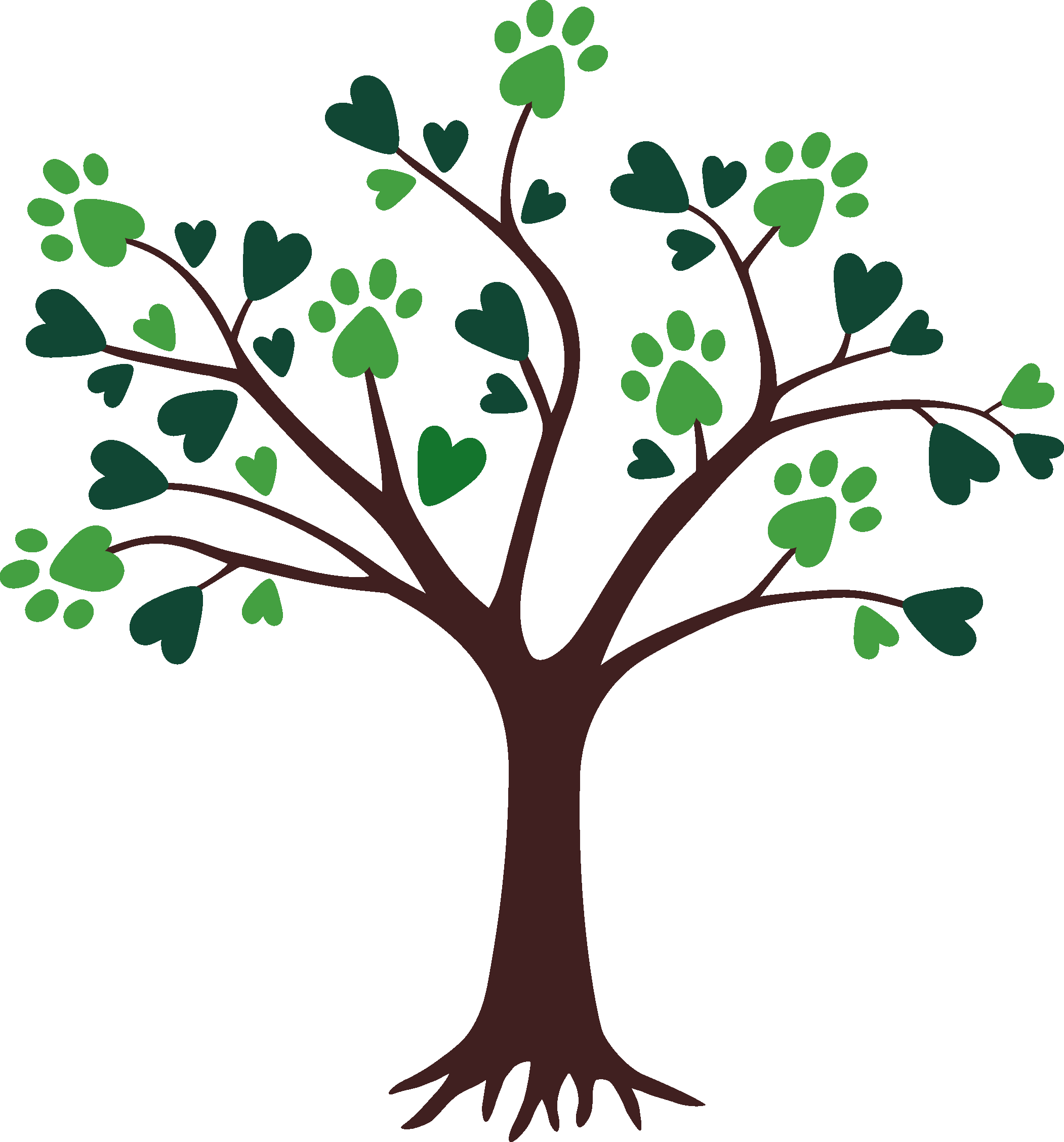How do you decide which pet food recipe and other nutrition products are right for my pet?
We have developed a complex algorithm, drawing on the expertise of our veterinarian advisory council and our Ph.D. in animal science and pet nutrition, to ensure your pet gets the healthy and nutritious diet they deserve.
Are your products natural?
Yes, all of our health products are natural and holistic.
Is pawTree food "organic?"
With all of our nutrition products, we focus on the best nutrition for our pets. When possible we use organic ingredients when cost effective and readily available. However our products are not labeled as "organic."
What is the difference between Natural and Organic?
All of pawTree's nutrition and health products are 'Natural’. This means that they do not contain any artificial colors, flavors or preservatives (as defined by AAFCO - Association of American Feed Control Officials). Organic is a term that is clearly defined by the USDA for various categories, though the pet food definition has not yet been defined. It states that the ingredients (organic meat, poultry, eggs, dairy and plant foods) come from farms that don’t use pesticides, antibiotics or hormones. In addition, a government-approved certifier must inspect the farm to ensure these standards are met.
Why is one particular protein source recommended vs. another? For example, Duck vs. Chicken? Or Salmon vs. Turkey?
The protein source is just one component of the recipe that's recommended for your pet. Your pet's age, weight, size, energy level, other health issues, etc. are all considered before recommending one of our recipes. So the protein source is not the deciding factor on which recipe is "right" for your pet, it's the full combination of ingredients, fat, protein, fiber, calories, etc. that determines the recommendation.
Why choose Grain-Free?
The benefits of a grain-free diet include:
Higher protein provides a better source of energy and nutrition
Easier to break-down and digest
More food is utilized resulting is less waste
May reduce food allergies/intolerances
When possible, we recommend feeding a grain-free diet to your pets, but sometimes budget constraints or particular situations require other alternatives, so we also have some pet food recipes with "healthy grains." All of our recipes live up to our pawTree Promise, and none of our recipes contain any corn, wheat, soy or any poultry by-products. All of our products use high-quality ingredients and deliver amazing results. Fill out a pet profile and see what we recommend for your pet!
What is 'meal?'
Meal is simply meat that has been dried, some fat has been removed, all water has been removed and it has been ground. Consistent with all manufacturers of dog food, we use 'meal' as well as meat, poultry or fish in our recipes to ensure the right consistency of our kibble.
Are any of the pawTree fish ingredients preserved with ethoxyquin before or after you buy it?
Absolutely not. We do not use any artificial preservatives like BHA, BHT or ethoxyquin.
Why do you use canola oil in some of your recipes?
Canola oil is a very good fat source, and the one we choose to use in our poultry free recipes, rather than chicken fat.
What is the carbohydrate level in each of the pawTree dog food recipes?
| Dog Food (Grain Free): |
| Food |
Carbohydrate % |
| Real Chicken & Sweet Potato Recipe (Fish Free) |
35.6% |
| Real Turkey & Sweet Potato Recipe (Fish Free and Chicken Free) |
35.6% |
| Real Salmon, Peas & Sweet Potato Recipe (Chicken Free) |
41% |
| Real Lamb, Chickpeas & Lentils Recipe (Poultry Free) |
41% |
| Real Turkey and Garbanzo Beans Recipe (Fish Free and Chicken Free) |
49% |
| Real Duck & Chickpeas Recipe (Fish Free and Chicken Free) |
49% |
| Real Trout, Sweet Peas & Lentils Recipe (Poultry Free) |
49% |
| Dog Food with Healthy Grains: |
| Food |
Carbohydrate % |
| Real Chicken & Oatmeal Recipe (Fish Free) |
40.9% |
| Real Whitefish & Brown Rice Recipe (Poultry Free) |
51.1% |
| Real Chicken & Brown Rice Recipe (Fish Free) |
51.1% |
| Real Turkey & Brown Rice Recipe (Fish Free) |
55.6% |
| Real Trout & Barley Recipe (Poultry Free) |
55.6% |
What is the carbohydrate level in each of the pawTree cat food recipes?
| Cat Food (Grain Free): |
| Food |
Carbohydrate % |
| Real Chicken Recipe |
26.2% |
| Real Chicken & Potato Recipe (Fish Free) |
31.9% |
| Real Salmon & Potato Recipe |
31.9% |
| Cat Food with Healthy Grains: |
| Food |
Carbohydrate % |
| Real Whitefish & Brown Rice Recipe |
32.9% |
| Real Turkey & Oatmeal Recipe (Fish Free) |
32.9% |
| Real Trout & Brown Rice Recipe |
38.6% |
| Real Turkey & Barley Recipe (Fish Free) |
38.6% |
What is the sodium content of your canned cat food?
The sodium content of our canned cat food ranges from 0.12% - 0.29% based on variety.
What is Gluten? How do I know if my pet is gluten intolerant, and is pawTree® pet food gluten free?
Gluten is simply the word that describes the protein portion of a carbohydrate. Gluten is found in grains such as wheat, barley, rye and triticale (a cross between wheat and rye), but not in rice, potatoes and some other carbohydrate sources. Most pets tolerate gluten and have no adverse effects from having it in their diet. However, some pets, like some people, cannot tolerate gluten. Pets that are sensitive to gluten develop a chronic small intestinal inflammatory disease if they eat it. They have intermittent or persistent diarrhea, lose weight, develop a poor coat, lose body condition and in general, fail to thrive. Gluten intolerance can affect any breed but is particularly well-documented in these certain dog breads - Irish Setters, Samoyeds, and Soft-Coated Wheaten Terriers. Pet Parents usually see signs of this condition by the time a dog reaches 6 or 7 months of age. All pawTree® dog and cat food is formulated with gluten-free ingredients. However, we do not make the claim 'gluten free' because there is a new ruling with the FDA that any human food claiming to be gluten free must be produced in a gluten-free facility and undergo constant testing with a new limit of 20 mg gluten/kg.
Which pawTree products are gluten free?
Gluten is simply the word that describes the protein portion of a carbohydrate. Gluten is found in grains such as wheat, barley, rye and triticale (a cross between wheat and rye), but not in rice, potatoes and some other carbohydrate sources.
Food: All of our grain-free dog and cat food is formulated only with gluten-free ingredients, including our canned cat food. The healthy grains formulas (both dog and cat) contain pearled barley.
pawPairings: All are made with only gluten-free ingredients
pawTreats: All are made with only gluten-free ingredients
Supplements:
Wild Alaskan Salmon Oil: Made with only gluten-free ingredients
Allergy Support Plus: Made with only gluten-free ingredients
Joint Support Plus:Joint Support Plus: Made with only gluten-free ingredients
Bladder Support Plus: Made with only gluten-free ingredients
Gastro Pro Plus: Made with only gluten-free ingredients
Brain Drops: Made with only gluten-free ingredients
Hairball Support Plus: Made with only gluten-free ingredients
Dental Sticks: Made with only gluten-free ingredients
Does pawTree have just one formula and they swap the flavor of the food? Is that what 'formulated' means?
No, our recipes are formulated to meet the different needs of pets, based on the information provided in their pet profiles.
How many different possible recommendations are there?
We have over 1,000 different combinations of recommendations for our customized nutrition plans, which include food, supplements and treats. We've gone to great care to be sure to get the right plan that is recommended for your pet.
Do you have any food without potatoes or sweet potatoes? My pet has a starch sensitivity and cannot eat potatoes.
All of our recipes do contain sweet potatoes at various levels, some with as little as 3%. However, if your pet cannot have any potatoes, we would suggest trying some of our supplements and high protein pawTreats, many of which do not contain potatoes or sweet potatoes.
My dog has had high copper toxicity levels in the past, how high is the copper level in the pawTree food?
The level of copper in our diets is in the 25-30 mg/kg range. Our Advisory Council recommends you consult with your Veterinarian for the most appropriate diet (and copper levels) for your dog as these levels may be too high for a dog with any type of inherited copper storage disease. If our recipes will not work for her, perhaps you would consider some of our supplements or our incredibly tasty and healthy natural treats as part of your dog's nutrition plan.
Does pawTree use any animal by-products?
pawTree products don't contain any poultry, fish, or meat by-products or by-product meal.
How can I learn about specific products, including ingredient statements and/or guaranteed analysis?
Visit the product facts page after clicking on the item of choice to view this information. Click here to view our products.
What is your commitment to quality?
see pawTree promise
What are the calories and carbohydrates for the supplements?
Allergy Support Plus: 3600 kcal/kg or 7 kcals/chew based on the small 2 g chews and 22 kcals/chew based on the large 6 g chews, and 60 carbs.
Bladder Support Plus: 3400 kcal/kg or 7 kcals/chew based on the 2 g chews, and 63 carbs.
Joint Support Plus: 3600 kcal/kg or 7 kcal/chew based on the small dog chew and small cat chew (2 g chews), and 22 kcals/chew based on the large dog 6 g chews, and 60 carbs.
Brain Support Plus: 3700 kcals/kg or 15 kcals/chew based on the small 4 g chews and 22 kcals/chew based on the large 6 g chews, and 52 carbs.
Hairball Support Plus: 4700 kcals/kg or 14.1 kcals/2 chews, and 55 carbs.
Are there nuts in any of the pawTree products?
No, none of our pawTree products contain nuts. However, they may be made in a facility that is not nut free.
Shop All Issues
Aches and Occasional Discomfort
Anxiety
Bad Breath
Bad Gas
Bladder Health
Boost Immune System
Cognitive Issues in Senior Dogs
Digestive Issues
Dry Skin
Dry, Rough, Cracked Pads or Noses
Dull Coat
Eats Poop
Excessive Shedding
Food Allergies
Hot Spots
Itch From Fleas
Itching (other)
Itchy or Smelly Ears
Loose Stool
Low Energy
Oral Health
Picky Eater
Pilling Pets
Red & Irritated Skin
Seasonal Allergies
Sensitive Stomach
Smelly, Stinky Pets
Stiff/Sore Joints
Tartar
Tear and Saliva Stains on Fur
Tracks in Dirt or Dirties Carpet
Urinary Tract Issues
Shop All Issues
Aches and Occasional Discomfort
Anxiety
Bad Gas
Bladder Health
Boost Immune System
Digestive Issues
Dry Skin
Dry, Rough, Cracked Pads or Noses
Dull Coat
Eats Poop
Excessive Shedding
Food Allergies
Hairball Control
Hot Spots
Itch From Fleas
Itching (other)
Itchy or Smelly Ears
Loose Stool
Low Energy
Picky Eater
PIlling Pets
Red & Irritated Skin
Seasonal Allergies
Sensitive Stomach
Smelly, Stinky Pets
Stiff/Sore Joints
Tear and Saliva Stains on Fur
Tracks in Dirt or Dirties Carpet
Urinary Tract Issues



